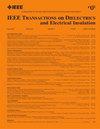200°C以下脉冲电声法测量空间电荷
IF 2.9
3区 工程技术
Q2 ENGINEERING, ELECTRICAL & ELECTRONIC
IEEE Transactions on Dielectrics and Electrical Insulation
Pub Date : 2024-12-25
DOI:10.1109/TDEI.2024.3521882
引用次数: 0
摘要
本文设计了一种改进的脉冲电声(PEA)装置,用于测试聚四氟乙烯(PTFE)在高温($90~^{\circ}$ C ~ $200~^{\circ}$ C)中的空间电荷分布,并设计了适用于高温测量的LiNbO3传感器和温度控制器。电压方案由30至50 kV/mm的电场应用组成,以30分钟的极化和去极化方式逐步施加。结果表明,LiNbO3可以作为传感器材料,在高达$200~^{\circ}$ C的高温下测试空间电荷,PTFE在$150~^{\circ}$ C以下没有明显的电荷注入。在$150~^{\circ}$ C以上,阳极注入大量的正电荷,并以空间电荷包的形式迁移到阴极。期望这种PEA测量技术有助于开发高温绝缘材料。本文章由计算机程序翻译,如有差异,请以英文原文为准。
The Space Charge Measurement by Pulsed Electroacoustic Method up to 200 ∘C
In this letter, an improved pulsed electroacoustic (PEA) device is modified to test the space charge distributions in polytetrafluoroethylene (PTFE) at high temperatures ( $90~^{\circ }$ C– $200~^{\circ }$ C). The LiNbO3 sensor and temperature controller suitable for high temperature’s measurement are designed. The voltage protocol is composed of electric field application from 30 to 50 kV/mm in a stepwise manner with 30-min polarization and depolarization. It shows that LiNbO3 can be used as a sensor material to test space charge at high temperatures up to $200~^{\circ }$ C. The PTFE has no obvious charge injection below $150~^{\circ }$ C. Above $150~^{\circ }$ C, the anode injects a large amount of positive charge, which migrates to the cathode in the form of space charge packets. It is expected that this PEA measurement technique is helpful to develop insulating materials for high temperatures.
求助全文
通过发布文献求助,成功后即可免费获取论文全文。
去求助
来源期刊
CiteScore
6.00
自引率
22.60%
发文量
309
审稿时长
5.2 months
期刊介绍:
Topics that are concerned with dielectric phenomena and measurements, with development and characterization of gaseous, vacuum, liquid and solid electrical insulating materials and systems; and with utilization of these materials in circuits and systems under condition of use.

 求助内容:
求助内容: 应助结果提醒方式:
应助结果提醒方式:


